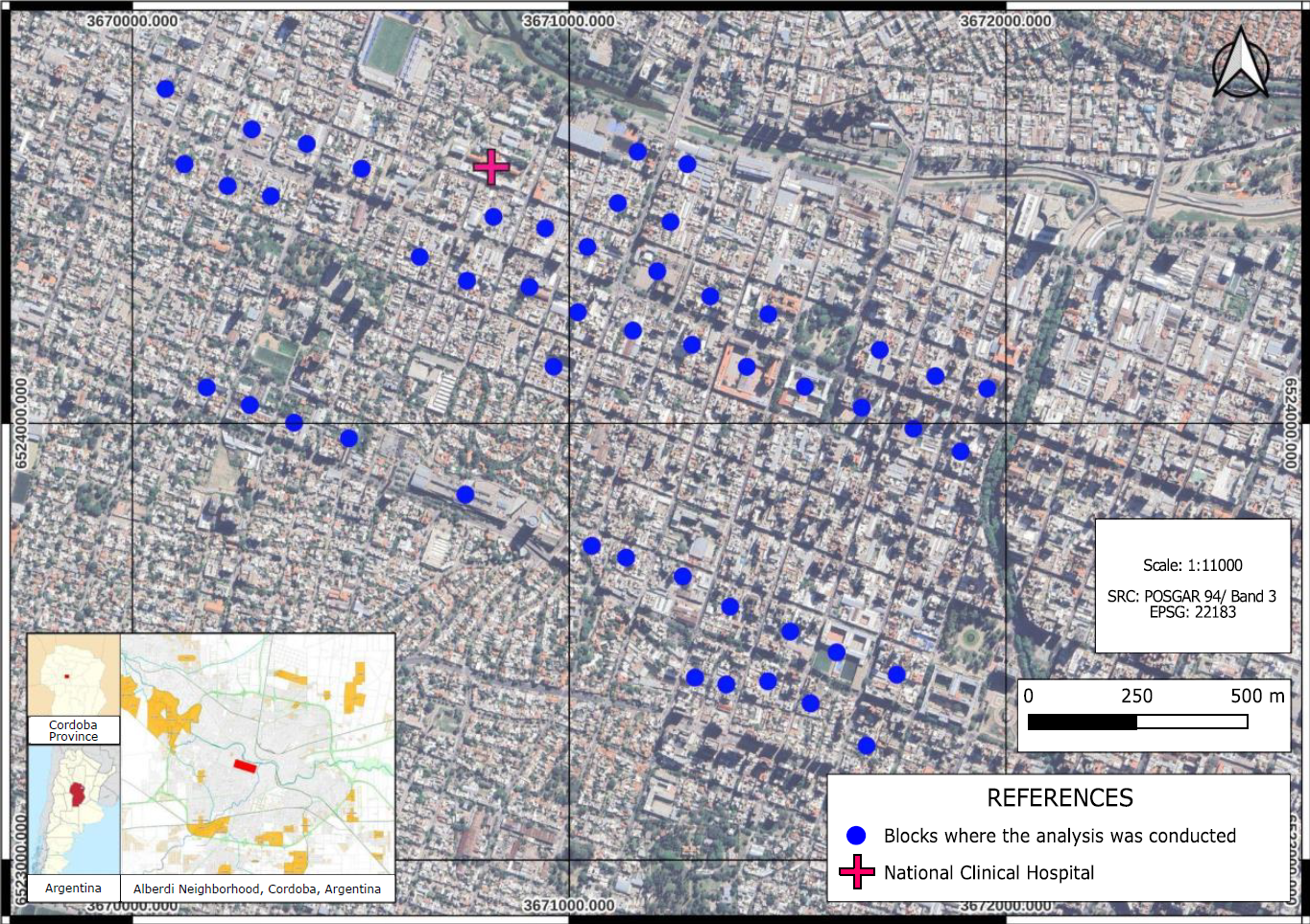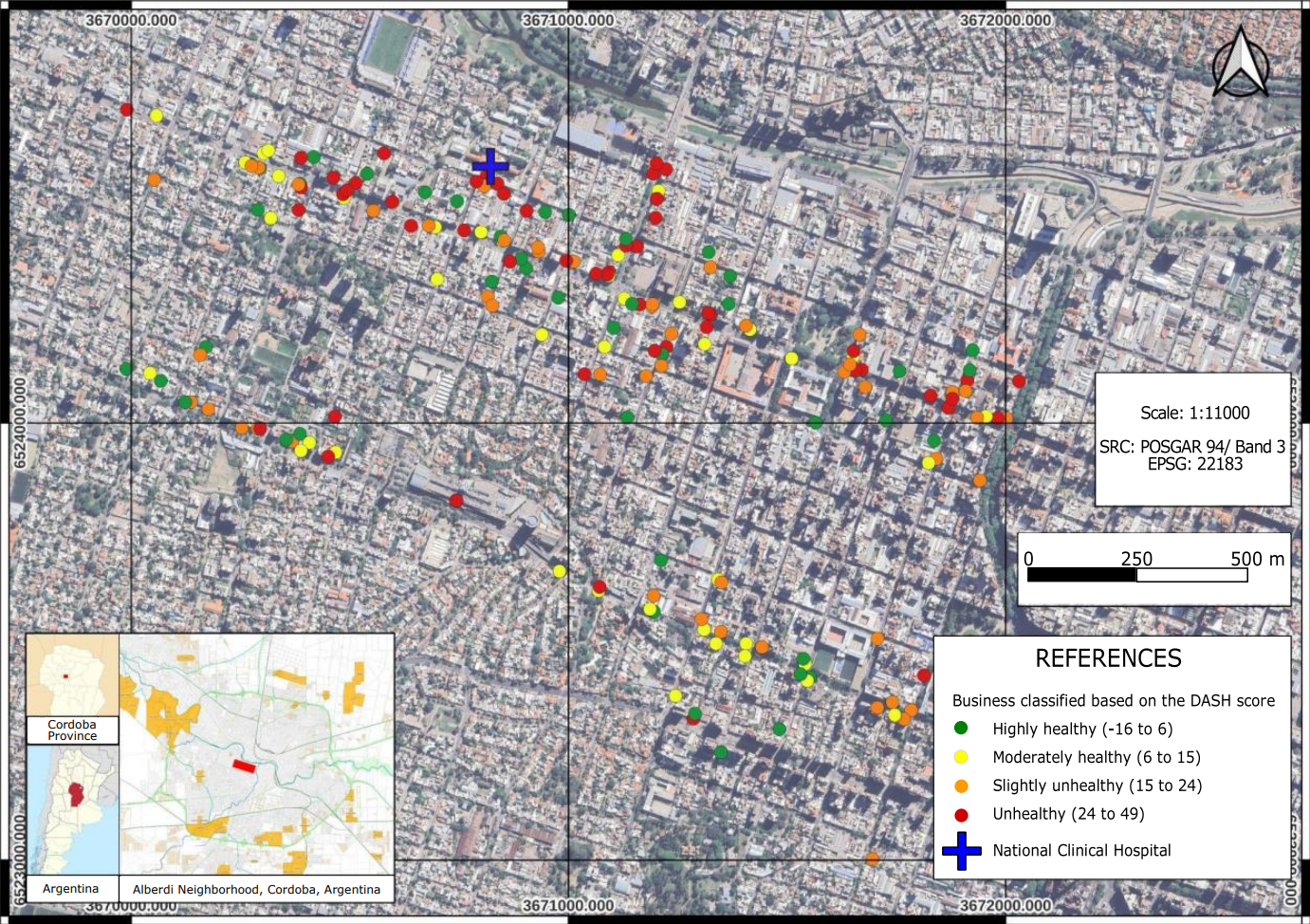Geospatial approach to study the food environment according to the DASH diet guidelines, an Argentinian experience
Enfoque geoespacial para estudiar el entorno alimentario según lineamientos de la dieta DASH, una experiencia Argentina
Abordagem geoespacial para estudar o ambiente alimentar segundo as diretrizes da dieta DASH, uma experiência Argentina
Citation: Campero MN, Scavuzzo CM, Oberto MG, Marchiori GN, Popelka RM, Defagó MD. Geospatial approach to study the food environment according to the DASH diet guidelines, an Argentinian experience. Univ. Salud. 2024; 26(3):E30-E37. DOI: https://doi.org/10.22267/rus.242603.336.
# Abstract
Introduction: The characteristics of the food environment influence food choices. Objective: To design and implement a methodology to explore the characteristics of the food environment in a central neighborhood of Córdoba, Argentina, based on the availability of food stores and following the recommendations of the DASH diet (Dietary Approaches to Stop Hypertension). Materials and Methods: 223 stores were analyzed to determine the type of establishment and the availability of foods based on the mentioned approaches. They were georeferenced using coordinates extracted from the Google Earth platform. Then, stores were classified, constructing a continuous quantitative variable that summarizes information about product sales in each place (DASH score). The thematic mapping and score construction were carried out using QGIS 3.22 software. Results: A high predominance of kiosks, bakeries, and fast-food outlets (59.5%) was observed, while stores selling only fresh food represented 17.4% of the total. Additionally, establishments considered 'unhealthy' were mostly located in the northern part of the Alberdi neighborhood in Córdoba. Conclusions: The proposed approach contributes to the study of food environments as a tool for preventing non-communicable diseases and promoting health.
Keywords: Food; DASH; spatial analysis; geographic information systems; epidemiology; public health.
# Resumen
Introducción: Las características del entorno alimentario condicionan la elección de alimentos. Objetivo: Diseñar e implementar una metodología para explorar las características del entorno alimentario en un barrio céntrico de la ciudad de Córdoba, Argentina, a partir de la disponibilidad de comercios y tiendas de alimentos acorde con las recomendaciones de la dieta DASH (Dietary Approaches to Stop Hypertension). Materiales y métodos: Se relevaron 223 comercios para determinar el tipo de establecimiento y la disponibilidad de alimentos en base a los enfoques mencionados y se georeferenciaron en base a coordenadas extraídas de la plataforma Google Earth. Se clasificaron los comercios construyendo una variable cuantitativa continua que resume la información sobre las ventas de productos en cada lugar (DASH Score). El mapeo temático y la construcción del Score se realizó con el software Qgis 3.22. Resultados: Se observó un alto predominio de quioscos, panaderías y locales de comida rápida (59,5 %) y los comercios que venden sólo alimentos frescos representaron el 17,4 % del total. Los establecimientos considerados no saludables se ubicaron más al norte del barrio. Conclusiones: El enfoque propuesto contribuye al estudio de los entornos alimentarios como una herramienta para la prevención de enfermedades no transmisibles y la promoción de la salud.
Palabras clave: Alimentos; DASH; análisis espacial; sistemas de información geográfica; epidemiología social; salud pública.
# Resumo
Introdução: As características do ambiente alimentar determinam a escolha dos alimentos. Objetivo: Desenhar e implementar uma metodologia para explorar as características do ambiente alimentar em um bairro central da cidade de Córdoba, Argentina, com base na disponibilidade de empresas e lojas de alimentos de acordo com as recomendações da dieta DASH (Dietary Approaches to Stop Hypertension). Materiais e métodos: Foram pesquisados 223 estabelecimentos comerciais para determinar o tipo de estabelecimento e a disponibilidade de alimentos com base nas abordagens citadas e georreferenciados com base em coordenadas extraídas da plataforma Google Earth. As empresas foram classificadas através da construção de uma variável quantitativa contínua que resume as informações sobre as vendas de produtos em cada localidade (DASH Score). O mapeamento temático e a construção do Score foram realizados com o software Qgis 3.22. Resultados: Observou-se grande predominância de quiosques, padarias e lanchonetes (59,5%) e os comércios que comercializam apenas alimentos in natura representaram 17,4% do total. Os estabelecimentos considerados insalubres localizavam-se mais ao norte do bairro. Conclusões: A abordagem proposta contribui para o estudo dos ambientes alimentares como ferramenta de prevenção de doenças não transmissíveis e promoção da saúde.
Palavras chave: Alimentação; DASH; análise espacial; sistemas de informação geográfica; epidemiologia; saúde pública.


